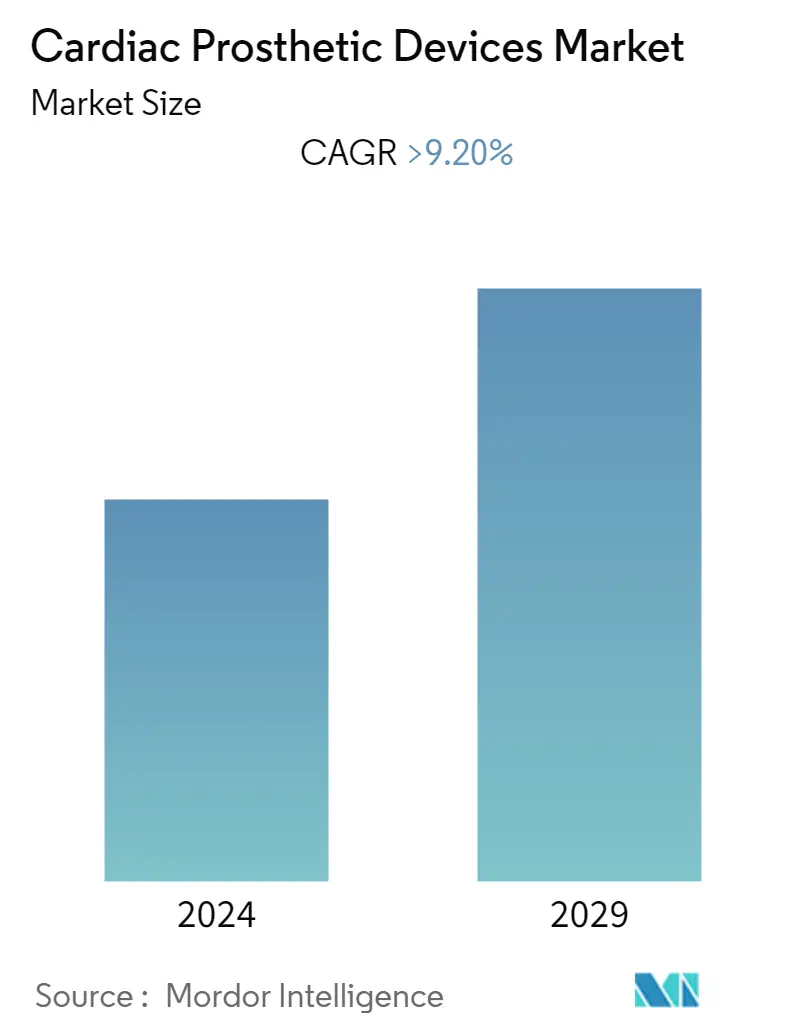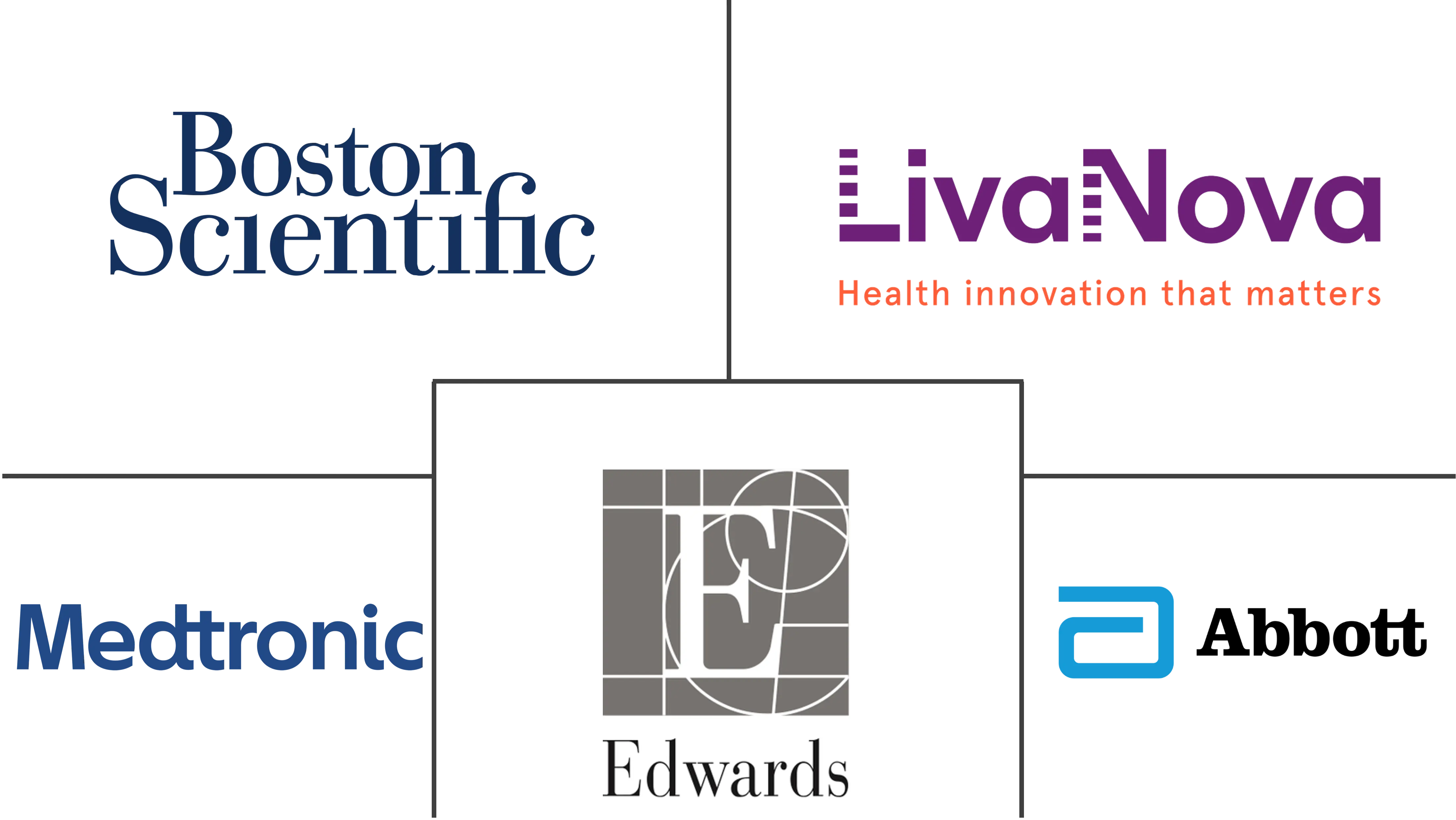Market Size of Cardiac Prosthetic Devices Industry

| Study Period | 2019 - 2029 |
| Base Year For Estimation | 2023 |
| CAGR | 9.20 % |
| Fastest Growing Market | Asia Pacific |
| Largest Market | North America |
| Market Concentration | Low |
Major Players
*Disclaimer: Major Players sorted in no particular order |
Cardiac Prosthetic Devices Market Analysis
The cardiac prosthetic devices market studied is anticipated to grow with a CAGR of nearly 9.2% during the forecast period.
COVID-19 had a significant impact on the cardiac prosthetic devices market owing to delayed cardiac consultation and surgical procedures. Moreover, many complications, such as prosthetic valve failure, were reported in COVID-19-infected patients. For instance, as per the article published in December 2022 in Springer, due to the hypercoagulability associated with COVID-19 infection, the risk of prosthetic valve failure and valve thrombosis was found to be more prone in hospitalized COVID-19-infected patients. However, in the post-pandemic situation, as the restriction was lifted, the market is expected to witness significant growth due to the increase in post covid cardiac complications and the rise in technological advancements in cardiac prosthetic devices.
The major factors attributing to the growth of the market are the rise in the prevalence of multiple cardiovascular indications, atrial fibrillation, cardiac valve failure, and stroke. For instance, as per the data from the CARES report 2021, 97.6% of adults and 2.4% of children were reported with out-of-hospital cardiac arrest in 2021 in the United States, and the median age of OHCA is considered to be 64 years. Hence, prosthetic devices are widely utilized to cope with the rising prevalence of cardiac complications globally and support cardiac health for a longer period, thereby driving market growth. Furthermore, the rise in the global geriatric population is likely to increase the market growth since cardiac complications rise with age. For instance, according to the World Population Prospects 2022 report published by the United Nations, the global geriatric population is increasing rapidly around the world, and between 2022 and 2050, the older population is projected to grow at rates above 3% per year in Northern Africa and Western Asia, sub-Saharan Africa, Oceania (excluding Australia and New Zealand) and Central and Southern Asia.
Moreover, product launches and strategic initiatives by the key players are expected to drive market growth over the forecast period. For instance, in June 2021, Medtronic launched Micra AV, a miniaturized, fully self-contained pacemaker that delivers advanced pacing technology to atrioventricular (AV) block patients via a minimally invasive approach. The device can sense atrial activity without a lead or device in the upper chamber of the heart. Thus, developments in medical devices like pacemakers are expected to increase in demand for cardiac prosthetic devices and lead to market growth over the forecast period.
Hence, due to the rise in cardiac complications, the increase in the geriatric population, and the surge in cardiac prosthetic device launches by the key players, the studied market is expected to drive market growth over the forecast period. However, the strict regulatory framework and the high cost of implantation, and the risk of repetitive surgeries are likely to restrain the market growth.
Cardiac Prosthetic Devices Industry Segmentation
As per the scope of the report, cardiac prosthetic devices are used to replace or support the function of damaged or infirm heart tissues or organs that help the cardiac functioning of the patients. Heart valve replacement devices and pacemakers have drawn a major attraction, with a steep rise in cardiac failure cases in recent years driving the market for cardiac prosthetic devices. The Cardiac Prosthetic Devices Market is Segmented by Product (Heart Valves and Pacemakers) and Geography (North America, Europe, Asia-Pacific, Middle East, Africa, and South America). The market report also covers the estimated market sizes and trends for 17 different countries across major regions globally. The report offers the value (in USD million) for the above segments.
| By Product | |||||
| |||||
|
| Geography | ||||||||
| ||||||||
| ||||||||
| ||||||||
| ||||||||
|
Cardiac Prosthetic Devices Market Size Summary
The cardiac prosthetic devices market is poised for substantial growth, driven by an increasing prevalence of cardiovascular conditions and advancements in medical technology. The market is recovering from the impacts of COVID-19, which had caused delays in cardiac consultations and surgeries, but is now expected to expand due to the rise in post-COVID cardiac complications. The growing geriatric population, coupled with the prevalence of conditions such as atrial fibrillation and cardiac valve failure, is further propelling market demand. Key players are actively launching innovative products, such as Medtronic's Micra AV pacemaker, which are expected to enhance the adoption of cardiac prosthetic devices. Despite challenges like stringent regulatory frameworks and high implantation costs, the market is set to benefit from the increasing need for durable and effective cardiac solutions.
North America is anticipated to experience significant growth in the cardiac prosthetic devices market, supported by a high prevalence of cardiovascular disorders and numerous product launches by leading companies. Initiatives like the collaboration between CIHI and CCS in Canada are contributing to improved cardiac care, further boosting market expansion. The region's advanced healthcare infrastructure and awareness campaigns promoting the benefits of modern prosthetics are also key factors driving market growth. The market is moderately fragmented, with major players such as Abbott Laboratories, LivaNova PLC, and Medtronic plc focusing on technological advancements to meet the evolving needs of cardiac patients. These developments, along with ongoing research and product approvals, are expected to sustain the market's upward trajectory over the forecast period.
Cardiac Prosthetic Devices Market Size - Table of Contents
-
1. MARKET DYNAMICS
-
1.1 Market Overview
-
1.2 Market Drivers
-
1.2.1 Rise in the Prevalence of Cardiac Diseases and Increase in Geriatric Population
-
1.2.2 Increase in Technological Advancements in Cardiac Prosthetics
-
-
1.3 Market Restraints
-
1.3.1 Strict Regulatory Framework
-
1.3.2 High Cost of Implantation and Risk of Repetitive Surgeries
-
-
1.4 Porter Five Forces
-
1.4.1 Threat of New Entrants
-
1.4.2 Bargaining Power of Buyers/Consumers
-
1.4.3 Bargaining Power of Suppliers
-
1.4.4 Threat of Substitute Products
-
1.4.5 Intensity of Competitive Rivalry
-
-
-
2. MARKET SEGMENTATION (Market Size by Value - USD Million)
-
2.1 By Product
-
2.1.1 Heart Valves
-
2.1.1.1 Tissue Valve
-
2.1.1.2 Transcatheter Valve
-
2.1.1.3 Mechanical Valve
-
-
2.1.2 Pacemaker
-
2.1.2.1 Implantable Pacemaker
-
2.1.2.2 External Pacemaker
-
-
-
2.2 Geography
-
2.2.1 North America
-
2.2.1.1 United States
-
2.2.1.2 Canada
-
2.2.1.3 Mexico
-
-
2.2.2 Europe
-
2.2.2.1 Germany
-
2.2.2.2 United Kingdom
-
2.2.2.3 France
-
2.2.2.4 Italy
-
2.2.2.5 Spain
-
2.2.2.6 Rest of Europe
-
-
2.2.3 Asia-Pacific
-
2.2.3.1 China
-
2.2.3.2 Japan
-
2.2.3.3 India
-
2.2.3.4 Australia
-
2.2.3.5 South Korea
-
2.2.3.6 Rest of Asia-Pacific
-
-
2.2.4 Middle East and Africa
-
2.2.4.1 GCC
-
2.2.4.2 South Africa
-
2.2.4.3 Rest of Middle East and Africa
-
-
2.2.5 South America
-
2.2.5.1 Brazil
-
2.2.5.2 Argentina
-
2.2.5.3 Rest of South America
-
-
-
Cardiac Prosthetic Devices Market Size FAQs
What is the current Cardiac Prosthetic Devices Market size?
The Cardiac Prosthetic Devices Market is projected to register a CAGR of greater than 9.20% during the forecast period (2024-2029)
Who are the key players in Cardiac Prosthetic Devices Market?
Abbott Laboratories, LivaNova PLC, Medtronic plc, Boston Scientific Corporation and Edwards Lifesciences Corporation are the major companies operating in the Cardiac Prosthetic Devices Market.

